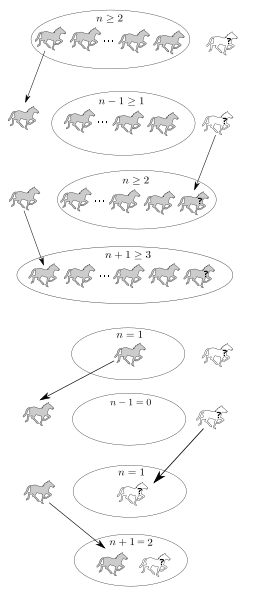All horses are the same color is a falsidical paradox that arises from a flawed use of mathematical induction to prove the statement All horses are the same color.[1] There is no actual contradiction, as these arguments have a crucial flaw that makes them incorrect. This example was originally raised by George Pólya in a 1954 book in different terms: "Are any n numbers equal?" or "Any n girls have eyes of the same color", as an exercise in mathematical induction.[2] It has also been restated as "All cows have the same color".[3]
The "horses" version of the paradox was presented in 1961 in a satirical article by Joel E. Cohen. It was stated a lemma, which in particular allowed the author to "prove" that Alexander the Great did not exist and he had an infinite number of limbs.[4]
The argument
horses' paradox, induction step failing for n = 1
The argument is proof by induction. First we establish a base case for one horse ( n=1). We then prove that if n horses have the same color, then n+1 horses must also have the same color.
Base case: One horse
The case with just one horse is trivial. If there is only one horse in the "group", then clearly all horses in that group have the same color.
Inductive step
Assume that n horses always are the same color. Consider a group consisting of n+1 horses.
First, exclude one horse and look only at the other n horses; all these are the same color since n horses always are the same color. Likewise, exclude some other horse (not identical to the one first removed) and look only at the other n {\displaystyle n} n horses. By the same reasoning, these too, must also be of the same color. Therefore, the first horse that was excluded is of the same color as the non-excluded horses, who in turn are of the same color as the other excluded horse. Hence the first horse excluded, the non-excluded horses, and last horse excluded are all of the same color, and we have proven that:
If n n horses have the same color, then n+1 horses will also have the same color.
We already saw in the base case that the rule ("all horses have the same color") was valid for n n=1. The inductive step proved here implies that since the rule is valid for n=1, it must also be valid for n=2, which in turn implies that the rule is valid for n=3 and so on.
Thus in any group of horses, all horses must be the same color.[2][5]
Explanation
The argument above makes the implicit assumption that the set of n n+1 horses has the size at least 3,[3] so that the two subsets of horses to which the induction assumption is applied have a common element. This is not true at the first step of induction, i.e., when \( {\displaystyle n+1=2} \).
Let the two horses be horse A and horse B. When horse A is removed, it is true that the remaining horses in the set are the same color (only horse B remains). The same is true when horse B is removed. However the statement "the first horse in the group is of the same color as the horses in the middle" is meaningless, because there are no "horses in the middle" (common elements (horses) in the two sets). Therefore, the above proof has a logical link broken. The proof forms a falsidical paradox; it seems to show by valid reasoning something that is manifestly false, but in fact the reasoning is flawed.
See also
Unexpected hanging paradox
When a white horse is not a horse
List of paradoxes
References
Łukowski, Piotr (2011). Paradoxes. Springer. pp. 15.
Pólya, George (1954). Induction and Analogy in Mathematics. Princeton University Press. p. 120.
Thomas VanDrunen, Discrete Mathematics and Functional Programming, Franklin, Beedle and Associates, 2012, Section "Induction Gone Awry"
Cohen, Joel E. (1961), "On the nature of mathematical proofs", Worm Runner's Digest, III (3). Reprinted in A Random Walk in Science (R. L. Weber, ed.), Crane, Russak & Co., 1973, pp. 34-36
"All Horses are the Same Color". Harvey Mudd College Department of Mathematics. Retrieved 6 January 2013.
Undergraduate Texts in Mathematics
Graduate Studies in Mathematics
Hellenica World - Scientific Library
Retrieved from "http://en.wikipedia.org/"
All text is available under the terms of the GNU Free Documentation License


